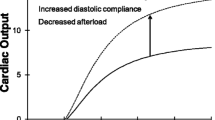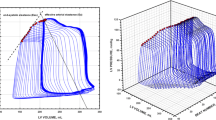Abstract
Ventricular compliance alterations can affect cardiac performance and adaptations. Moreover, diastolic mechanics are important in assessing both diastolic and systolic function, since any filling impairment can compromise systolic function. A sigmoidal passive filling pressure–volume relationship, developed using chronically instrumented, awake-animal disease models, is clinically adaptable to evaluating diastolic dynamics using subject-specific micromanometric and volumetric data from the entire filling period of any heartbeat(s). This innovative relationship is the global, integrated expression of chamber geometry, wall thickness, and passive myocardial wall properties. Chamber and myocardial compliance curves of both ventricles can be computed by the sigmoidal methodology over the entire filling period and plotted over appropriate filling pressure ranges. Important characteristics of the compliance curves can be examined and compared between the right and the left ventricle and for different physiological and pathological conditions. The sigmoidal paradigm is more accurate and, therefore, a better alternative to the conventional exponential pressure–volume approximation.






Similar content being viewed by others
References
Zhang, S. J., Truskey, G. A., & Kraus, W. E. (2007). Effect of cyclic stretch on1D-integrin expression and activation of FAK and RhoA. American Journal of Physiology - Cell Physiology, 292, C2057–C2069.
Pasipoularides, A. (2010). Heart's vortex: intracardiac blood flow phenomena. Shelton: People’s Medical Publishing House.
Borlaug, B. A., & Redfield, M. M. (2011). Diastolic and systolic heart failure are distinct phenotypes within the heart failure spectrum. Circulation, 123, 2006–2013.
Mirsky, I., & Pasipoularides, A. (1990). Clinical assessment of diastolic function. Progress in Cardiovascular Diseases, 32, 291–318.
Hayley, B. D., & Burwash, I. G. (2012). Heart failure with normal left ventricular ejection fraction: role of echocardiography. Current Opinion in Cardiology, 27, 169–180.
Zile, M. R., Baicu, C. F., & Gaasch, W. H. (2004). Diastolic heart failure: abnormalities in active relaxation and passive stiffness of the left ventricle. The New England Journal of Medicine, 350, 1953–1959.
Kass, D. A., Bronzwaer, J. G., & Paulus, W. J. (2004). What mechanisms underlie diastolic dysfunction in heart failure? Circulation Research, 94, 1533–1542.
Pasipoularides, A. (1988). On mechanisms of improved ejection fraction by early reperfusion in acute myocardial infarction: myocardial salvage or infarct stiffening? (Editorial). Journal of the American College of Cardiology, 12, 1037–1038.
Redfield, M. M. (2004). Understanding "diastolic" heart failure. The New England Journal of Medicine, 350, 1930–1931.
Segers, V. F., Brutsaert, D. L., & De Keulenaer, G. W. (2012). Pulmonary hypertension and right heart failure in heart failure with preserved left ventricular ejection fraction: pathophysiology and natural history. Current Opinion in Cardiology, 27, 273–280.
Pasipoularides A, Mirsky I, Hess OM, Krayenbuehl HP (1980) Incomplete relaxation and passive diastolic muscle properties in man. Circulation, 62, III-205.
Pasipoularides, A., Mirsky, I., Hess, O. M., Grimm, J., & Krayenbuehl, H. P. (1986). Myocardial relaxation and passive diastolic properties in man. Circulation, 74, 991–1001.
Paulus, W. J. (2010). Culprit mechanism(s) for exercise intolerance in heart failure with normal ejection fraction. [Editorial]. Journal of the American College of Cardiology, 56, 864–866.
LeWinter, M. M., & Pavelec, R. (1982). Influence of the pericardium on left ventricular end-diastolic pressure-segment relations during early and late stages of experimental chronic volume overload in dogs. Circulation Research, 50, 501–509.
Little, W. C., & Ohara, T. (2011). Left atrial emptying reserve: a mirror of LV diastolic function that predicts prognosis? JACC. Cardiovascular Imaging, 4, 389–391.
Dulhunty, A. F. (2006). Excitation-contraction coupling from the 1950s into the new millennium. Clinical and Experimental Pharmacology and Physiology, 33, 763–772.
Pasipoularides, A., Palacios, I., Frist, W., Rosenthal, S., Newell, J. B., & Powell, W. J., Jr. (1985). Contribution of activation-inactivation dynamics to the impairment of relaxation in hypoxic cat papillary muscle. American Journal of Physiology - Regulatory, Integrative and Comparative Physiology, 248, R54–R62.
Bers, D. M. (2002). Cardiac excitation-contraction coupling. Nature, 415, 198–205.
Cerra, M. C., & Imbrogno, S. (2012). Phospholamban and cardiac function: a comparative perspective in vertebrates. Acta Physiologica, 205, 9–25.
Pasipoularides, A. D., Shu, M., Shah, A., & Glower, D. D. (2002). Right ventricular diastolic relaxation in conscious dog models of pressure overload, volume overload and ischemia. The Journal of Thoracic and Cardiovascular Surgery, 124, 964–972.
Pasipoularides, A. (2011). LV twisting-and-untwisting in HCM: ejection begets filling. Diastolic functional aspects of HCM. [Progress in Cardiology]. American Heart Journal, 162, 798–810.
Pasipoularides, A., & Mirsky, I. (1988). Models and concepts of diastolic mechanics: pitfalls in their misapplication. Mathematical and Computer Modelling, 11, 232–234.
Mirsky, I. (1984). Assessment of diastolic function: suggested methods and future considerations. Circulation, 69, 836–841.
Mirsky, I., & Pasipoularides, A. (1980). Elastic properties of normal and hypertrophied cardiac muscle. Federation Proceedings, 39, 156–161.
Gaasch, W. H., & Zile, M. R. (2011). Left ventricular structural remodeling in health and disease: with special emphasis on volume, mass, and geometry. [Review]. Journal of the American College of Cardiology, 58, 1733–1740.
Zile, M. R., & Brutsaert, D. L. (2002). New concepts in diastolic dysfunction and diastolic heart failure. Circulation, 105, 1387–1393.
Resar, J. R., Judd, R. M., Halperin, H. R., Chacko, V. P., Weiss, R. G., & Yin, F. C. (1993). Direct evidence that coronary perfusion affects diastolic myocardial mechanical properties in canine heart. Cardiovascular Research, 27, 403–410.
Graham, H. K., Horn, M., & Trafford, A. W. (2008). Extracellular matrix profiles in the progression to heart failure. Acta Physiologica, 194, 3–21.
Craig, W. E., Murgo, J. P., & Pasipoularides, A. (1987). Calculation of the time constant of relaxation. In W. Grossman & B. Lorell (Eds.), Diastolic relaxation of the heart (pp. 125–132). The Hague: Martinus Nijhoff.
Condos, W. R. J., Latham, R. D., Hoadley, S. D., & Pasipoularides, A. (1987). Hemodynamics of the Mueller maneuver in man: right and left heart micromanometry and Doppler echocardiography. Circulation, 76, 1020–1028.
Williams, L., & Frenneaux, M. (2006). Diastolic ventricular interaction: from physiology to clinical practice. Nature Reviews Cardiology, 3, 368–376.
Belenkie, I., Smith, E. R., & Tyberg, J. V. (2001). Ventricular interaction: from bench to bedside. Annals of Medicine, 33, 236–241.
Boudoulas, H., Weinstein, P. B., Shaver, J. A., & Wooley, C. F. (1987). Atrial septal defect: attenuation of respiratory variation in systolic and diastolic time intervals. Journal of the American College of Cardiology, 9, 53–58.
Gelpi, R. I., Pasipoularides, A., Lader, A. S., Patrick, T. A., Chase, N., Hittinger, L., Shannon, R. P., Bishop, S. P., & Vatner, S. F. (1991). Changes in diastolic cardiac function in developing and stable perinephritic hypertension in conscious dogs. Circulation Research, 68, 555–567.
Komamura, K., Shannon, R. P., Pasipoularides, A., Ihara, T., Lader, A. S., Patrick, T. A., Bishop, S. P., & Vatner, S. F. (1992). Alterations in left ventricular diastolic function in conscious dogs with pacing-induced heart failure. The Journal of Clinical Investigation, 89, 1825–1838.
Pasipoularides, A. (1992). Cardiac mechanics: basic and clinical contemporary research. Annals of Biomedical Engineering, 20, 3–17.
Pasipoularides, A. D., Shu, M., Shah, A., Silvestry, S., & Glower, D. D. (2002). Right ventricular diastolic function in canine models of pressure overload, volume overload and ischemia. American Journal of Physiology - Heart and Circulatory Physiology, 283, H2140–H2150.
Saeki, Y., Sagawa, K., & Suga, H. (1978). Dynamic stiffness of cat heart muscle in Ba2+-induced contracture. Circulation Research, 42, 324–333.
Little, R. C., & Wead, W. B. (1971). Diastolic viscoelastic properties of active and quiescent cardiac muscle. American Journal of Physiology, 221, 1120–1125.
Minelli, R., Panagia, V., & Reggiani, C. (1973). The stiffness of parallel elastic elements in rat papillary muscle. Pflügers Archiv, 339, 79–84.
Paulus, W. J., Vantrimpont, P. J., & Rousseau, M. F. (1992). Diastolic function in nonfilling human left ventricle. Journal of the American College of Cardiology, 20, 1524–1532.
Brutsaert, D. L., & Sys, S. U. (1989). Relaxation and diastole of the heart. Physiological Reviews, 69, 1228–1315.
Pogessi, C., Reggiani, C., Bottinelli, R., Ricciardi, L., & Minelli, R. (1983). Relaxation in atrial and ventricular myocardium: activation decay and different load sensitivity. Basic Research in Cardiology, 78, 256–265.
Lecarpentier, Y. C., Chuck, L. H. S., Housmans, P. R., DeClerck, N. M., & Brutsaert, D. L. (1979). Nature of load dependence of relaxation in cardiac muscle. American Journal of Physiology - Heart and Circulatory Physiology, 237, H455–H460.
Zhang, W., & Kovacs, S. J. (2008). The diastatic pressure-volume relationship is not the same as the end-diastolic pressure-volume relationship. American Journal of Physiology - Heart and Circulatory Physiology, 294, H2750–H2760.
Borlaug, B. A., Jaber, W. A., Ommen, S. R., Lam, C. S., Redfield, M. M., & Nishimura, R. A. (2011). Diastolic relaxation and compliance reserve during dynamic exercise in heart failure with preserved ejection fraction. Heart, 97, 964–969.
Tschöpe, C., & Paulus, W. J. (2009). Doppler echocardiography yields dubious estimates of left ventricular diastolic pressures. Circulation, 120, 810–820.
Jaber, W. A., Lam, C. S. P., Meyer, D. M., & Redfield, M. M. (2007). Revisiting methods for assessing and comparing left ventricular diastolic stiffness: impact of relaxation, external forces, hypertrophy, and comparators. American Journal of Physiology - Heart and Circulatory Physiology, 293, H2738–H2746.
Ihara, T., Shannon, R. P., Komamura, K., Pasipoularides, A., Patrick, T., Shen, Y. T., & Vatner, S. F. (1994). Effects of anesthesia and recent surgery on diastolic function. Cardiovascular Research, 28, 325–336.
Straley, C. A. (1993). New model of ventricular filling dynamics: sigmoidal pressure-volume relations. Durham: Duke University (Thesis).
Stefanadis, C., Dernellis, J., Tsiamis, E., Diamantopoulos, L., Michaelides, A., & Toutouzas, P. (2000). Assessment of aortic line of elasticity using polynomial regression analysis. Circulation, 101, 1819–1825.
Pasipoularides, A. (1990). Clinical assessment of ventricular ejection dynamics with and without outflow obstruction. [Review]. Journal of the American College of Cardiology, 15, 859–882.
Pasipoularides, A., Shu, M., Womack, M. S., Shah, A., von Ramm, O., & Glower, D. D. (2003). RV functional imaging: 3-D echo-derived dynamic geometry and flow field simulations. American Journal of Physiology - Heart and Circulatory Physiology, 284, H56–H65.
Gibbons Kroeker, C. A., Adeeb, S., Tyberg, J. V., & Shrive, N. G. (2006). A 2D FE model of the heart demonstrates the role of the pericardium in ventricular deformation. American Journal of Physiology - Heart and Circulatory Physiology, 291, H2229–H2236.
Heerman, J. R., Segers, P., Roosens, C. D., Gasthuys, F., Verdonck, P. R., & Poelaert, J. I. (2005). Echocardiographic assessment of aortic elastic properties with automated border detection in an ICU: in vivo application of the arctangent Langewouters model. American Journal of Physiology - Heart and Circulatory Physiology, 288, H2504–H2511.
Pasipoularides, A., Uppal, R., Straley, C. A., Craig, D., Hampton, T. G., Shim, Y., Glower, D. D., & Smith, P. K. (1993). Left-ventricular filling dynamics: sigmoidal pressure-volume relations. Circulation, 88, I57.
Pasipoularides, A. (2011). Fluid dynamic aspects of ejection in hypertrophic cardiomyopathy. [Review]. Hellenic Journal of Cardiology, 52, 416–426.
Grose, R., Maskin, C., Spindola-Franco, H., & Yipintsoi, T. (1981). Production of left ventricular cavitary obliteration in normal man. Circulation, 64, 448–455.
Pasipoularides, A. (2012). Optimal hematocrit: a Procrustean bed for maximum oxygen transport rate? [Invited Editorial]. Journal of Applied Physiology, 113, 353–354.
Discher, D. E., Janmey, P. A., & Wang, Y.-L. (2005). Tissue cells feel and respond to the stiffness of their substrate. Science, 310, 1139–1143.
Engler, A. J., Sen, S., Sweeney, H. L., & Discher, D. E. (2006). Matrix elasticity directs stem cell lineage specification. Cell, 126, 677–689.
Karantalis, V., Balkan, W., Schulman, I. H., Hatzistergos, K. E., & Hare, J. M. (2012). Cell-based therapy for prevention and reversal of myocardial remodeling. American Journal of Physiology - Heart and Circulatory Physiology, 303, H256–H270.
Acknowledgments
Research support, for work in the author’s Laboratory surveyed in this Review, was provided by the National Heart, Lung, and Blood Institute [grant number R01 NIH 50446]; the National Science Foundation [grant number CDR 8622201]; and the North Carolina Supercomputing Center and Cray Research.
Conflict of interest
The author declares that he has no conflict of interest.
Author information
Authors and Affiliations
Corresponding author
Rights and permissions
About this article
Cite this article
Pasipoularides, A. Right and Left Ventricular Diastolic Pressure–Volume Relations: A Comprehensive Review. J. of Cardiovasc. Trans. Res. 6, 239–252 (2013). https://doi.org/10.1007/s12265-012-9424-1
Received:
Accepted:
Published:
Issue Date:
DOI: https://doi.org/10.1007/s12265-012-9424-1




